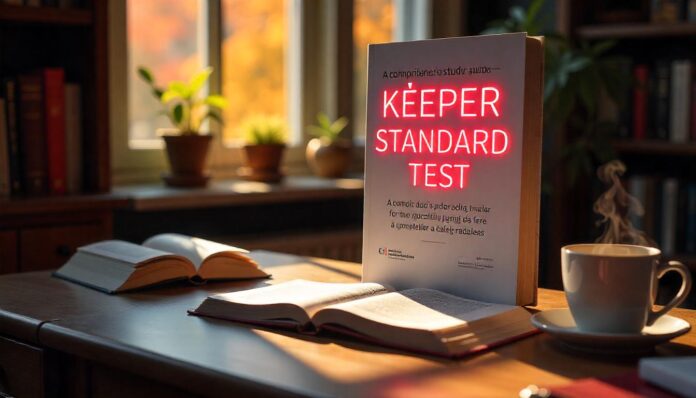Preparing for the Keeper Standard Test can be a pivotal step in your professional development. Whether you’re aiming to qualify for a specific role, meet company standards, or enhance your performance metrics, a strategic approach is essential. In this guide, we will walk you through how to prepare for the Keeper Standard Test efficiently, using academically proven methods and test-taking strategies.
Introduction to the Keeper Standard Test
The Keeper Standard Test is designed to assess a candidate’s ability to manage digital information securely, efficiently, and in accordance with best practices in password management and cybersecurity hygiene. It often includes a combination of multiple-choice questions, scenario-based assessments, and task simulations aimed at evaluating technical understanding, practical skills, and critical thinking.
Who Takes the Keeper Standard Test?
Typically, this test is required for professionals working with the Keeper Security platform or organizations implementing password management solutions. IT administrators, cybersecurity professionals, and general employees seeking compliance certifications may all be required to pass this test.
Understanding the Keeper Standard Test Format
Before you begin preparing, it’s crucial to familiarize yourself with the test format. While specifics can vary by version and employer, most Keeper Standard Tests include:
- Multiple-choice questions on features and settings
- Scenario-based questions about common security challenges
- Task simulations using the Keeper platform
- Compliance and policy-based questions
Time limits may apply, with most tests designed to be completed in 30 to 60 minutes.
Step 1: Review the Official Keeper Documentation
Start by reviewing the official Keeper Security documentation, which serves as the test’s foundational material. Keeper provides resources such as:
- User guides
- Admin setup manuals
- Security architecture overviews
- Compliance and privacy documents
Focusing on these areas will give you a direct understanding of the content likely to appear on the test.
Topics to Prioritize:
- Vault management
- Zero-knowledge architecture
- Role-based access controls
- BreachWatch, Security Audit, and Reporting tools
- Two-factor authentication (2FA) and SSO integrations
Step 2: Create a Study Plan
A structured study plan can dramatically improve your retention and confidence. Here’s a suggested weekly schedule if you have 2–4 weeks to prepare:
Week 1:
- Day 1–2: Introduction to Keeper platform & interface
- Day 3–4: Vault and folder organization
- Day 5: Practice tasks using test environment or demo
- Day 6–7: Review with flashcards and summaries
Week 2:
- Day 8–9: Advanced features like BreachWatch and secure file storage
- Day 10–11: Compliance and governance topics
- Day 12: Review key security terms (zero-knowledge, encryption)
- Day 13–14: Take a mock test and analyze your performance
Repeat high-impact areas in Week 3 and finalize weak areas in Week 4.
Step 3: Use Practice Tests and Simulations
Practice tests are among the best tools to prepare for the Keeper Standard Test. These help you:
- Familiarize yourself with test question styles
- Reduce test anxiety through simulation
- Identify weak content areas for focused revision
Where to Find Practice Tests:
- Official Keeper training portals
- Internal LMS platforms used by your company
- Third-party cybersecurity training vendors
Aim to complete at least 3 full-length practice tests, reviewing your results thoroughly.
Step 4: Learn Through Practical Application
One of the best ways to retain information is through hands-on practice. If your organization provides a Keeper test environment or sandbox:
- Create and manage sample vaults
- Experiment with role-based permissions
- Simulate a password breach and follow mitigation steps
- Practice generating security reports
If a sandbox environment isn’t available, use Keeper’s free trial (if offered) or video walkthroughs from certified trainers.
Step 5: Understand Compliance and Policy Frameworks
The Keeper Standard Test also measures your understanding of regulatory frameworks and organizational security policies. Key frameworks to understand include:
- SOC 2 compliance
- GDPR and HIPAA regulations
- NIST cybersecurity standards
Familiarity with these can help answer governance-related questions confidently, especially in real-world scenarios.
Step 6: Use Memorization Aids
Given the test’s technical nature, memory aids can help you retain terminology and feature sets:
Flashcards:
Create digital or physical flashcards for terms like:
- Zero-knowledge
- TOTP vs. HOTP
- Role Enforcements
- Master password best practices
Acronyms:
Develop your own acronyms for sequences of steps or features.
Example: “RACE” for Role setup, Admin approval, Credential sharing, Encryption checks.
Step 7: Prepare for Test Day
Success on test day depends not just on knowledge, but also on test-taking strategies.
Test-Day Tips:
- Rest well the night before
- Avoid cramming in the last hour
- Log in early to test technical requirements
- Keep note paper (if permitted) to jot down tricky terms
- Stay calm and manage time effectively—don’t spend too long on one question
If the test is proctored online, ensure your camera, mic, and ID are ready for verification.
Conclusion: Your Path to Keeper Test Success
The Keeper Standard Test is more than just a checkbox—it’s a validation of your ability to protect sensitive data in a high-stakes digital environment. With a focused study plan, regular practice tests, and hands-on experience, you can approach the exam with confidence. Remember to use official Keeper resources, supplement your learning with simulations, and understand the test objectives clearly.
By following the structured steps outlined in this guide, you can maximize your chances of passing the Keeper Standard Test on your first attempt. Good luck!


